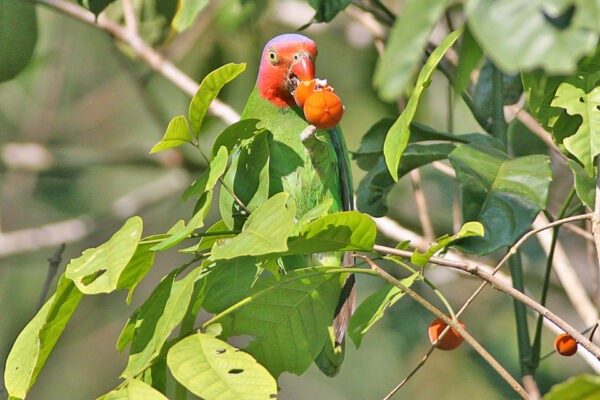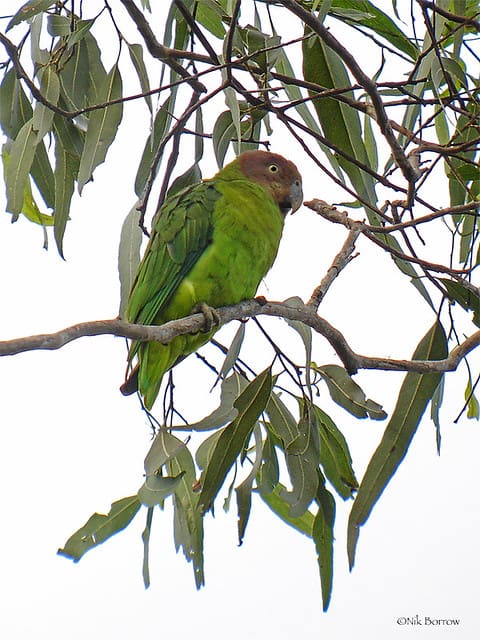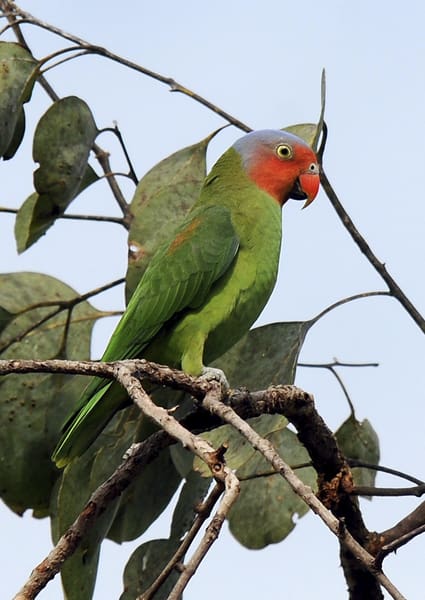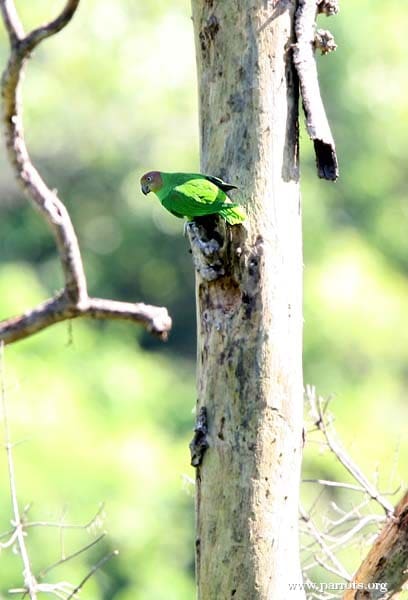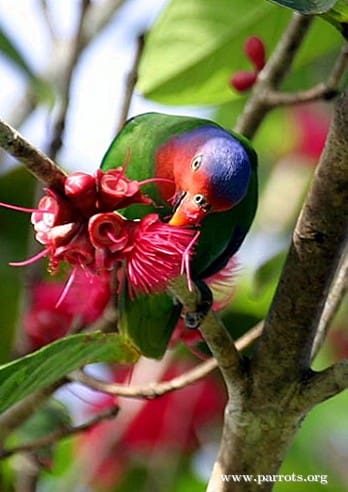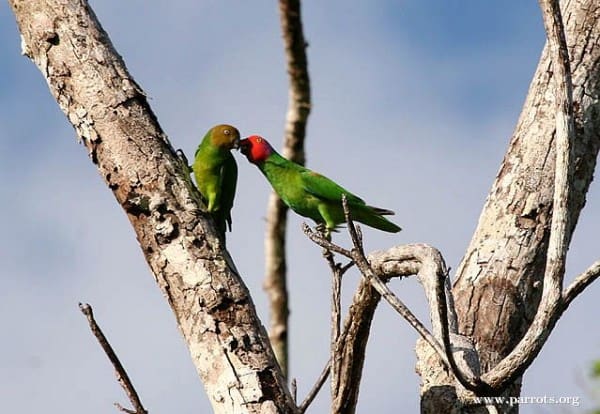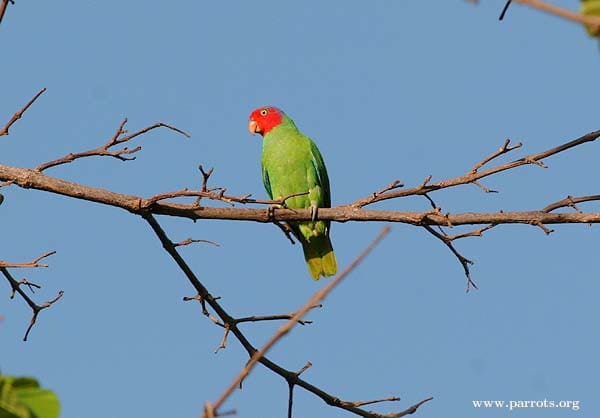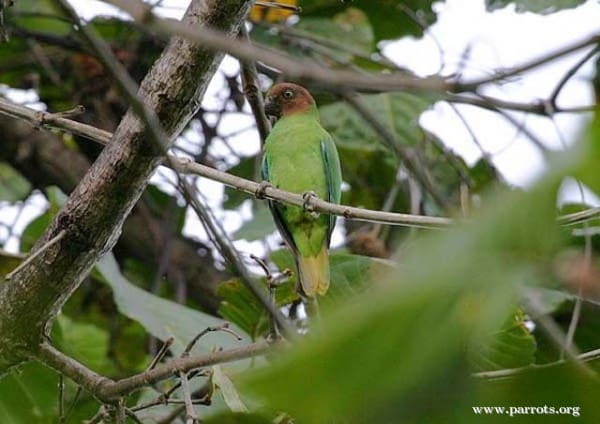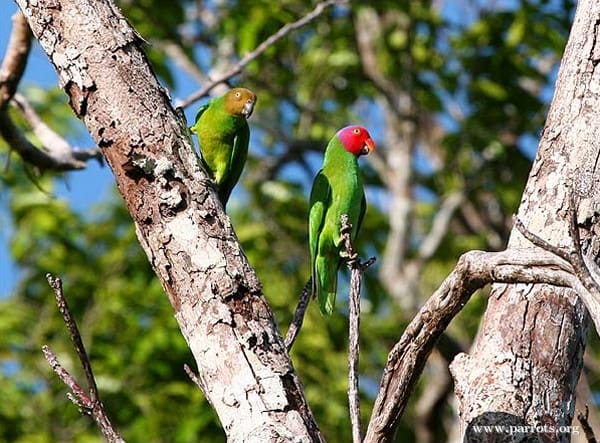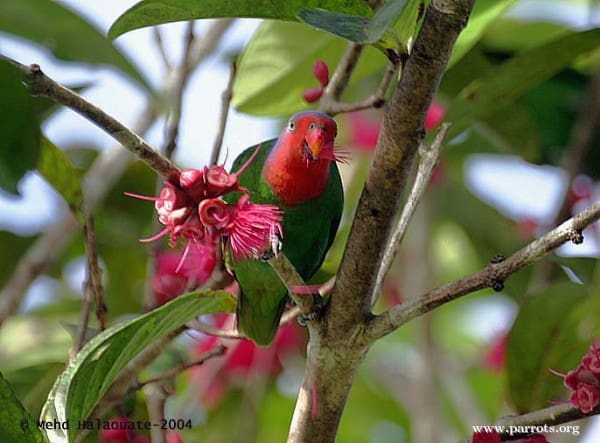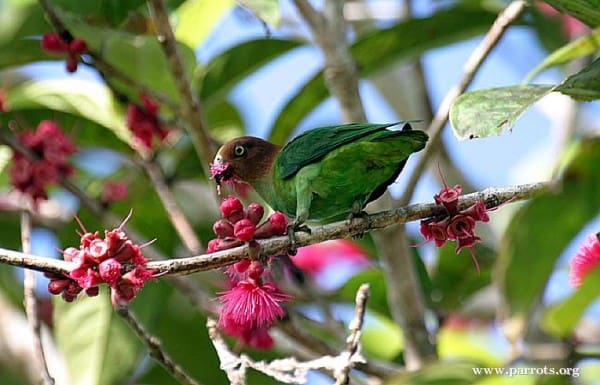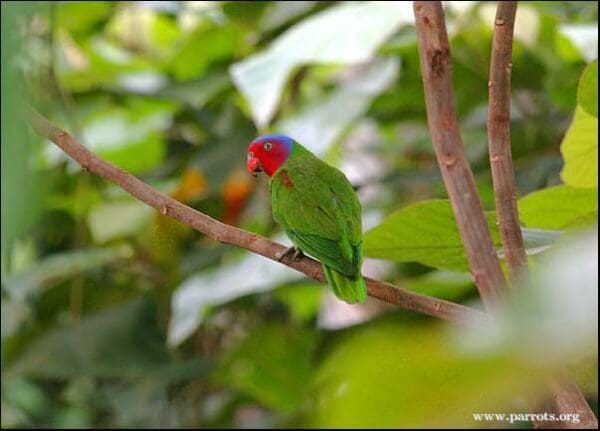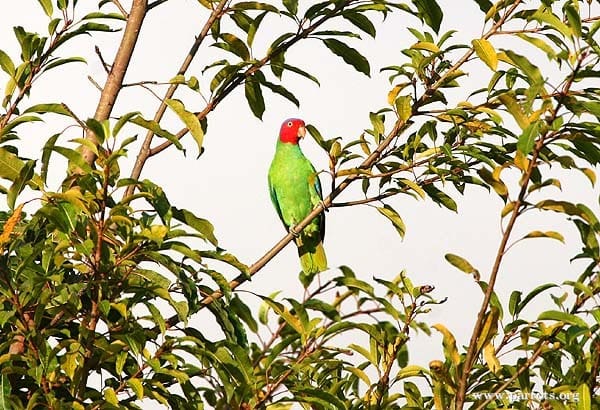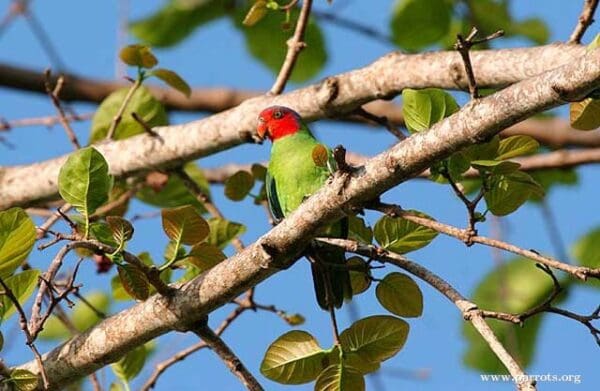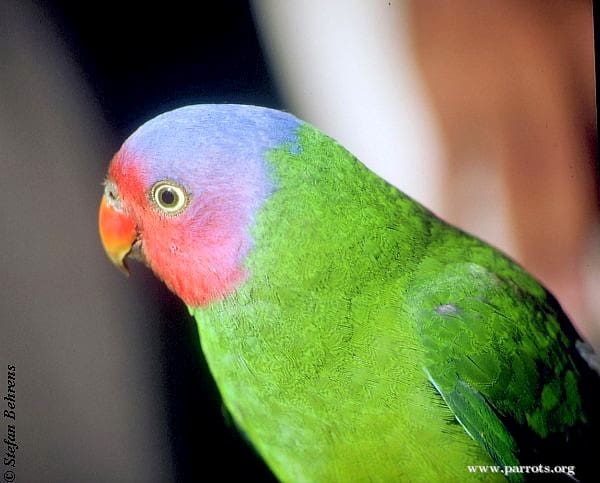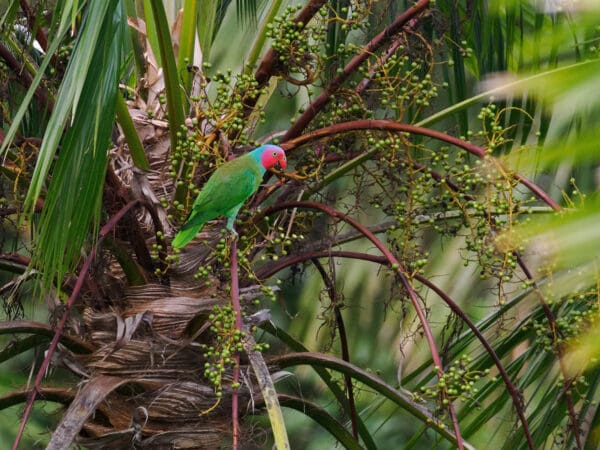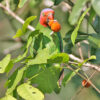
![© Nik Borrow [CC BY-SA 2.0] via Flickr A wild female Red-cheeked Parrot perches in a tree](https://parrots.org/wp-content/uploads/2023/01/wpt_Red-cheeked-Parrot_1277-17-100x100.jpg)
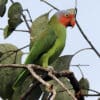
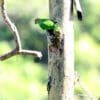
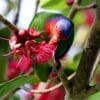
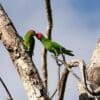
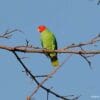
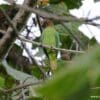
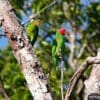
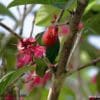
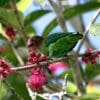

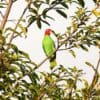
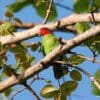
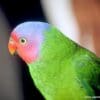
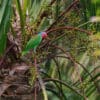
DID YOU KNOW?
The Red-cheeked Parrot will display and call from a perch above the canopy, standing very upright with beak pointing to the sky and vibrating its wings in cue with contact calls.

Geoffroyus

geoffroyi
Size:
21 cm (8.2 in)
Weight:
135-180 g (4.7-6.3 oz)
Subspecies including nominate:
seventeen: G.g. geoffroyi, G.g. floresianus, G.g. cyanicollis, G.g. rhodops, G.g. keyensis, G.g. timorlaoensis, G.g. aruensis, G.g. maclennani, G.g. sudestiensis, G.g. cyanicarpus, G.g. minor, G.g. jobiensis, G.g. mysoriensis, G.g. pucherani, G.g. obiensis. G.g. explorator, G.g. orientalis
Colour Adult:
G.g. geoffroyi: Male-red forehead to sides of head; lilac/blue crown and occiput; green nape to hindneck; inner median wing coverts red/brown; blue underwing coverts. Red upper mandible, brown lower mandible. Eye yellow. Female-brown head. Beak brown.
G.g. floresianus: Male-as in geoffroyi, but in general darker; purple/blue of crown is darker and reaches to nape; inner median wing coverts darker red/brown; darker blue underwing coverts. Larger in size. Beak larger. Female-crown darker brown and reaches to nape; otherwise as in male.
G.g. cyanicollis: Male-in general darker than geoffroyi; purple/blue of crown reaching to hindneck, meeting with evident blue collar; bronze/brown variable wash on mantle and upper back; blue/green upper breast and lower abdomen; red/brown on inner median wing coverts absent; darker blue underwing coverts. Larger in size. Female-head darker than that of geoffroyi; purple suffusion on crown; blue nape reaching evident blue collar; otherwise as in male.
G.g. rhodops: Male-as in floresianus, but in general darker; mark on inner median wing coverts dark brown/red; blue crown sharply separated from red of face; darker blue underwing coverts. Larger in size. Female-dark brown chestnut crown; otherwise as in male.
G.g. keyensis: Male-as in floresianus, but in general more yellow/green, particularly tail; pink/red cheeks and ear coverts washed with lilac/blue; faint yellow/green collar across hindneck and darker green stripe on foreneck; pale blue underwing coverts. Larger in size. Female-paler chestnut/brown on head; otherwise as in male.
G.g. timorlaoensis: Both adults as in keyensis, but smaller in size.
G.g. aruensis: Male-as in geoffroyi, but darker purple/blue of crown reaching to nape; inner median wing coverts has darker red/brown marking; darker blue underwing coverts. Female-darker brown of crown reaches to nape; otherwise as in male.
G.g. maclennani: Male-as in aruensis, but darker; red of face more dark and uniform; paler blue underwing coverts. Female-as in aruensis, but darker; darker brown head; paler blue underwing coverts.
G.g. sudestiensis: Male-as in aruensis, but underparts darker; red/brown marker on inner median coverts absent. Female-dark green crown and nape; otherwise as in male.
G.g. cyanicarpus: Male-as in aruensis, but with lilac/blue wash on cheeks and ear coverts; bend of wing to outside primary feather has blue edge. Female-as in aruensis, but brown crown and nape, with slight green tint; blue edge on outside of wing as in male.
G.g. minor: Male-as in aruensis, but with brown/red lower back to rump; darker red face; bronze/brown wash on mantle; marking on inner wing coverts minimal or absent. Female-as in aruensis, but slightly darker brown head; otherwise as in male.
G.g. jobiensis: Both adults as in minor, but with paler blue underwing coverts; bright red lower back to rump; in male, red on forehead reaches back to forecrown.
G.g. mysoriensis: Male-as in minor, but purple/blue of crown reaching down over hindneck, and red in face reaching to throat; bronze/brown wash of mantle absent; red/brown marking extensive on inner median wing coverts; darker blue underwing coverts; dark maroon lower back to rump, is less brown. Female-as in minor, but brown in crown reaching over hindneck; otherwise as in male.
G.g. pucherani: Both adults as in minor, with bronze marking on inner median wing covert minimal or absent; mantle has less bronze/brown wash; paler brown lower back to rump with less red; dark blue underwing coverts.
G.g. obiensis: Both adults as in cyanicollis but blue hindneck collar wider and reaching up nearly to eye; purple/blue in male or brown in female not reaching below occiput; red/brown lower back to rump.
G.g. orientalis: Not described.
G.g. explorator: Not described.
Colour Juvenile:
G.g. geoffroyi: Green head, red/brown on inner median wing coverts absent. Bill yellow. Eye brown.
Call:
Calls made in flight or when perched are distinctive; shrieking and metallic series of notes repeated rapidly; also two-syllable notes ending with upward inflection and a variety of croaking, chattering notes and shrill screeches.
More Information:
Content Sources:
CITES
BirdLife International
Cornell Lab of Ornithology/Birds of the World
Parrots: A Guide to Parrots of the World, Juniper and Parr, 1998
Parrots of the World, Forshaw, 2006. 2010 edition
Captive Status:
Virtually unknown in aviculture.
Longevity:
—
Housing:
Aviary at least 2.5 x 1 x 2 m (8.2 x 3.3 x 6.5 ft). Minimum temperature 24 C (75 F).
Diet:
Fruits such as: ripened and half-ripened banana, apple, pear, orange; sprouted seeds; lory nectar made from: honey, pollen, brewer’s yeast, oat flakes, multi-grain mix, vitamins and minerals; rusk or biscuit softened in filtered water or milk; small amounts of millet sprays, canary, oats, sprouted sunflower seed; complete pellet if taken.
Enrichment:
—
Nest Box Size:
—
Clutch Size:
2-4
Fledging Age:
—
Hatch Weight:
—
Peak Weight:
—
Weaning Weight:
—
World Population:
Unknown but recorded as common or abundant. Decreasing.
IUCN Red List Status:
Least Concern
CITES Listing:
Appendix II
Threat Summary:
Generally not globally threatened, but has been affected by the wild bird trade. Common to abundant throughout much of range; subspecies aruensis population restricted.
Range:
G.g. geoffroyi: Timor, Semau and Wetar, Lesser Sunda Islands, Indonesia.
G.g. floresianus: Lombok, Sumbawa, Flores and Sumba, Lesser Sunda Islands.
G.g. cyanicollis: Morotai, Halmahera, and Bacan, N Moluccas, Indonesia.
G.g. rhodops: Buru, Seram, Boano, Ambon, Haruku, Saparua, Manawoka, Gorong, and Seram Laut Islands, S Moluccas, Indonesia.
G.g. keyensis: Kai Kecil and Kai Besar, in Kai Islands, Indonesia.
G.g. timorlaoensis: Tanimbar Islands, Indonesia.
G.g. aruensis: Aru Islands, Indonesia, and S New Guinea, also Fergusson and Goodenough Islands, E Papuan Islands.
G.g. maclennani: E Cape York Peninsula, N Queensland, Australia.
G.g. sudestiensis: Misima and Tagula Islands, in Louisiade Archipelago, E Papua New Guinea.
G.g. cyanicarpus: Rossel Island, in Louisiade Archipelago, E Papua New Guinea.
G.g. minor: N New Guinea.
G.g. jobiensis: Yapen and Mios Num Islands, Geelvink Bay, West Papua.
G.g. mysoriensis: Biak and Numfoor Islands, Geelvink Bay, West Papua.
G.g. pucherani: W Papuan Islands, Indonesia and W New Guinea, to West Papua.
G.g. obiensis: Obi Island and Bisa Island, N Moluccas, Indonesia.
G.g. orientalis: Huon Peninsula (NE New Guinea).
G.g. explorator: Seram Laut Island (E of Seram).
Habitat:
Found up to 800 m (2624 ft) in primary and secondary forests, savanna with trees, plantations, open woodland, mangrove and farmland.
Wild Diet:
Feeds on nuts, fruits, berries, flower buds, blossoms; also seeds within fruit, such as Eucalyptus papuana, Casuarina papuana and Alpinia. Also seen taking fruit of the savanna tree Antidesma gaisambulla and Ganophyllum falcatum, and mistletoe.
Ecology and Behaviour:
Leaves roosting area early in morning to begin feeding. Found in pairs or small groups, feeding inconspicuously in the tree tops. Noisy and boisterous first thing in the morning and at dusk when returning to roost, with much calling and acrobatic flying.
Clutch and Egg Size:
2-4 eggs 29.0 x 25.0 mm (1.1 x 1 in).
Breeding Season:
April-August, Lesser Sunda Islands; February-October, New Guinea; August-December, Australia. Nest is in cavity excavated by female in dead trunk or branch.
Related Links:
—
